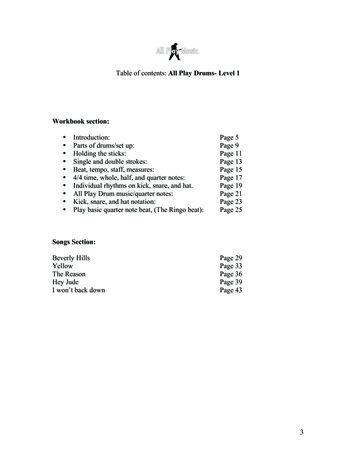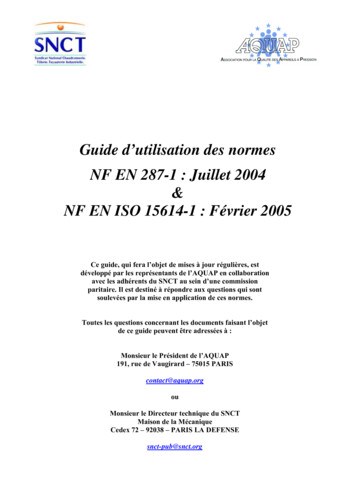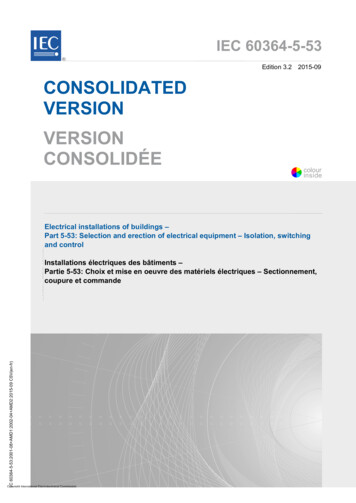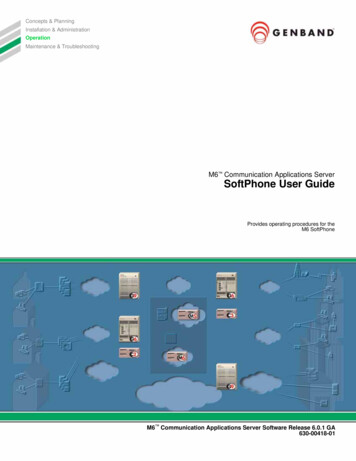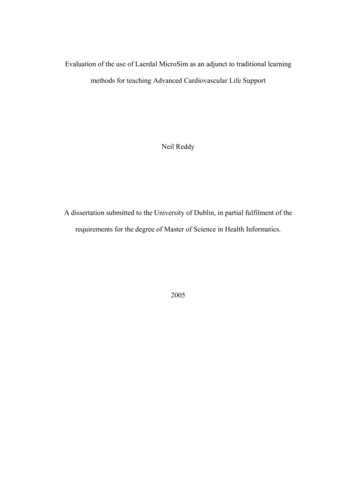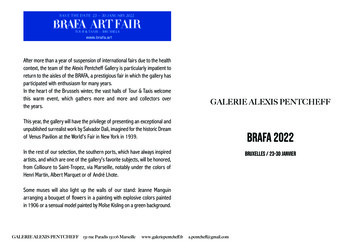
Transcription
After more than a year of suspension of international fairs due to the healthcontext, the team of the Alexis Pentcheff Gallery is particularly impatient toreturn to the aisles of the BRAFA, a prestigious fair in which the gallery hasparticipated with enthusiasm for many years.In the heart of the Brussels winter, the vast halls of Tour & Taxis welcomethis warm event, which gathers more and more and collectors overthe years.GALERIE ALEXIS PENTCHEFFThis year, the gallery will have the privilege of presenting an exceptional andunpublished surrealist work by Salvador Dali, imagined for the historic Dreamof Venus Pavilion at the World's Fair in New York in 1939.BRAFA 2022In the rest of our selection, the southern ports, which have always inspiredartists, and which are one of the gallery's favorite subjects, will be honored,from Collioure to Saint-Tropez, via Marseille, notably under the colors ofHenri Martin, Albert Marquet or of André Lhote.Bruxelles / 23-30 janvierSome muses will also light up the walls of our stand: Jeanne Manguinarranging a bouquet of flowers in a painting with explosive colors paintedin 1906 or a sensual model painted by Moïse Kisling on a green background.GALERIE ALEXIS PENTCHEFF131 rue Paradis 13006 com
An exceptional surrealist work ofSalvador Dali realized in the framework ofthe World's Fair in New-York in 1939
SalvadorDALI (1904 -1989)Le rêve de Vénus , 1939Project for a living paintingfor the Dream of Venus pavilion,New-York World's Fair, 1939Oil on canvaslined on cardboard,signed and dated 1939on the top right corner,40,5 x 50,5 cm.Provenance :Former Alain de Léché collectionPrivate collection, FranceGALERIE ALEXIS PENTCHEFF131 rue Paradis 13006 com
An exceptional surrealist work of Salvador Dali realized in the framework of the World's Fair of New-York in 1939In June 1939, Dali imagines for the World's Fair of New York a surrealist work inthe form of a whole pavilion, an architecture like Gaudi’s, ephemeral andinteractive, called The Dream of Venus.On the building's baroque façade, a Boticelli Venus sits alongside sculptures ofmermaids, while a fish head served as the entrance window, topped by a pair ofspread legs. Inside, visitors were immersed in a dreamlike world of installations,including two pools that hosted an aquatic show of nude naiads and aroom in which one could watch Venus sleeping.Shortly before, an exhibition at the Julien Levy Gallery in New York (from March21 to April 18, 1939) had been organized as a prelude to the great surrealistcoup d'éclat that was the pavilion at the World's Fair, which was to make Frenchsurrealism better known across the Atlantic and which in fact one of the firstinstallations of the history of art.Between popular fairground attraction, theater, architecture, painting and dance,the Dream of Venus Pavilion was intended to be a true immersive artisticexperience.The painting that we present, illustrating the room of Venus, testifies to theAmerican adventure of Salvador Dali and the evolution of its practice towards acontemporary art such as one will experiment it after the war in the secondpart of the XXth century.Coming from a private collection, it formerly belonged to the viscountAlain de Léché.GALERIE ALEXIS PENTCHEFF131 rue Paradis 13006 com
Continuation of the BRAFA 2022selection Alexis Pentcheff Gallery
HenriMANGUIN (1874 -1949)La bouquetière, 1906Oil on canvas,signed lower leftand dated 1906,92 x 73 cm.Provenance :Private collection, FranceHistory :Acquired from H. Manguinby H. Bonan, Tunis, 1939Sale, Paris, Palais Galliera,1967, n 67Coll. Mrs Joseph King, 1981Gallery Urban, Paris.Exhibitions :Manguin, Galerie de l'Elysée, Paris, 1938, n 2.Norton Gallery and Schoolof Arts, Florida, 1981.Bibliography :Lucile and Claude Manguin(dir.), Henri Manguin, catalog raisonné de l'oeuvrepeint, Ides et Calendes,Neuchâtel, 1980, reproducedunder no. 245 on p.117GALERIE ALEXIS PENTCHEFF131 rue Paradis 13006 comHenri Manguin, the painter of happinessManguin is one of the early Fauves, representedin the outrageous hall of the 1905 Salond'automne by five of his paintings. The whole ofits work is characterized by the happiness whichemerges from it, that of its happiness familyhappiness that can be read in his paintings.In a southern light, Henri Manguin paints his wifeJeanne, his favorite model, arranging an opulentbouquet of flowers whose tones echo her toilet.Of an exquisite freshness, this painting gives usus to see the family intimacy of the painter, thehappiness and the quietude of a spring morningin the South. An outstanding colorist, Manguinopposes here warm tones that he declines in thelower part of the painting and for the toiletof Jeanne, to cooler tones that blossom inthe background.
Henri MARTIN (1874 -1949)Le port de CollioureOil on canvas, signed lower left, 73 x 85 cm.Henri Martin in CollioureProvenance :Estate of the artistPrivate collection, FranceIn 1923, Henri Martin bought a house in Collioure. He went thereevery summer until the beginning of the war. In July, he leftLabastide-du-Vert, his southern resort, to go a little furthersouth, to this small port that the Fauves had adored.The painter Henri Marre was a childhood friend of Henri Martin.They were both students at the Toulouse School of Fine Arts andhe is a lover of Collioure, where he likes to live part of the year.He took his friend into the narrow streets of the picturesque littleport, which also held the artist's interest. Henri Martin ends upnot only buying a house there but also to rent a studio onthe port.From pictorial emotions to artistic friendships, since the Fauves,this is how Collioure conquered the painters, like SaintTropez at the same time. Sunny and picturesque, in the hollowof the Vermeille coast and influenced by nearby Spain, Henri Martin's motives were not limited to the return of anchovy fishing onthe quays animated by blue and pink silhouettes, but his sensitivity also led him, as in Labastide which he loved so much, to theold stones of the houses.GALERIE ALEXIS PENTCHEFF131 rue Paradis 13006 com
Albert MARQUET (1874 -1947)Marseille, le Vieux Port et Notre-Dame de la Garde, 1916Oil on canvas, signed lower left, 54 x 73 cm.History:Purchased by Druet from Marquet in 1916Galerie Druet, Paris (on the back of theframe, label of the Gallery Druet n 11031)Galerie Schmit, Paris, 1967Albert Marquet,Marseille at the time of the First World WarExhibitions :Buenos Aires, Argentina, Amigos del Arte, 1926Oslo, Norway and Helsingfors, Finland, 1927La Rochelle, 1927Paris, Schmit Gallery, May 17 - June 17, 1967Bibliography:Exhibition catalog, Schmidt Gallery, May 17 - June 17, 1967, No. 43 in the catalog and reproduced on p.55In 1905, responding to Manguin's invitation to Saint-Tropez,Marquet stayed for a while at the Villa Demière. Camoin joinedhim, marking the starting point of a studious coastal journey.The two artists traveled along the sea, went to Agay to paintwith Valtat and Cross, and visited Marseille.It was during the First World War, between 1916 and 1918,that Marquet returned to the city, renting a studio on the RiveNeuve quay overlooking the port. From this point of view, hecould devote himself to the observation of a teeming life,which was organized around the basin, crowned by the Pontbridge that connects the two banks of the harbor.Here, however, Marquet switches sides and stands in front ofhis studio, on the town hall side, to observe, in the backgroundthe misty silhouette of Notre-Dame de la Garde.In the foreground, Marquet captures (notably through attitudes and movements) an instantaneousness that givessubstance to the pictorial reality, to the point of pictorial reality,to the point of conferring to him, in a way a little paradoxically,a character of universality and permanence.GALERIE ALEXIS PENTCHEFF131 rue Paradis 13006 com
André LHOTE(1878 -1962)André Lhote was born in Bordeaux in 1885 into a modest family. He joineda cabinet making workshop where he learned ornamental wood carving andthen began to take courses at the School of Fine Arts in his native city.In 1905, he decided to devote himself to painting and left the sculptureworkshop, despite his parents' advice to the contrary. He was introducedto the paintings of Gauguin and Cézanne which seemed to him to be arevelation of modernity in painting. He met Jacques Rivière (1886-1925),the future director of La Nouvelle Revue Française, who became one of hisclose friends.In 1907, Lhote was admitted to the Salon d'Automne, which he attendedevery year. He also exhibited at the Cercle de l'Art Moderne in Le Havrefrom 1909 and the following year the Druet Gallery gave him his firstprivate exhibition.Around 1912, his research, inspired by primitive art and Romanesquefrescoes, led him to develop a new formal approachnew formal approach: cubism, which he appropriated in a rather personalconception. He exhibited in Stockholm in 1913 and then at the GalerieVildrac in the spring of the following year.André LhoteNu au bateauxOil on canvas, signed lower right, 60 x 48 cm.Provenance :Private collection, FranceGALERIE ALEXIS PENTCHEFF131 rue Paradis 13006 com
André LhotePort méditerranéenGALERIE ALEXIS PENTCHEFFOil on paper lined on canvas, stamped lower right, 69 x 86 cm.Provenance :Collection André Lhote Collection Simone Lhote Private collection, South of France131 rue Paradis 13006 com
From 1917, Lhote taught painting at the Atelier libre, boulevard du Montparnasse and joined the group of synthetic cubism. Between 1918 and1921, he also taught at the Atelier d'Études, boulevard Raspail, at theAcadémie moderne, rue Notre-Dame des champs and at the AcadémieMontparnasse.At the end of the First World War, he began his activities as an art critic,notably with the Nouvelle Revue Française (the painter was integrated intothe "Young French Painting" group) and took a position, in his writings andconferences, on polemical issues concerning modern painting. In 1921,Lhote exhibited at the Rosenberg Gallery.After the Second World War, he settled in La Cadière d'Azur. He travels toEgypt, Brazil.In the 1950s, he executed a large decoration for the Faculty of Medicine inBordeaux, published several essays and received the Grand PrixNational Prize of Arts. Many retrospectives are devoted to him, including bythe National Museum of Modern Art. The artist died in January 1962.In 1925, he opened the André Lhote Academy on rue d'Odessa, in the Montparnasse district, which received students from all over the world, includingTamara de Lempicka, Hans Hartung, etc. He taught there until the endof his life.Lhote discovered the village of Mirmande in the Drôme and began to reviveit. He set up his summer academy there, attracting painters and loversof old stones.On the occasion of the 1937 International Exhibition of Arts and Techniques,Lhote composed two large panels for the Palais de la Découverte: The Gasand The Derivatives of Coal. The following year, he discovered the village ofGordes where he bought a house. He will welcome Chagall during the war.GALERIE ALEXIS PENTCHEFF131 rue Paradis 13006 com
Moïse KISLING (1891 -1953)Nu sur un fond vertOil on canvas, signed lower right, 35 x 27 cm.It was on the advice of Pankiewicz, his teacher at the School of Fine Arts in Krakow,that Moïse Kisling, of Polish origin, arrived in Paris in 1910.In Montparnasse, he met Juan Gris, Picasso, Soutine and Modigliani, with whom hebecame particularly close friends. He visited Brittany, intrigued by the profoundrenewal initiated by the Pont-Aven School.In 1913, he also went to Céret, which was then called "the Mecca of Cubism".and where Matisse regularly enjoys staying. The young man was influenced by thegreat artistic figures of the beginning of the century, first and foremost Cézanne,whose lesson was beginning to be understood and applied. Like him, he endeavorsto paint still lifes of a great sobriety, which are pretext to the construction by facetsof geometrical forms.But Kisling's inspirations are broader, they intertwine to form his own style, givingbirth to melancholic and sensual characters, to explosive bouquets or to resolutelyconstructed landscapes. At the crossroads of several influences, he develops asingular expression, filled with an of an enigmatic sensuality, as evidenced by this"Nude on a green background".Provenance:Private collection, South of FranceIn 1919, the Druet Gallery gave him his first exhibition. Shortly after the SecondWorld War and after returning from several years of exile in the United States, farfrom his family, the painter settled in Sanary in the villa he had built at the end ofthe previous decade. From the 1920s onwards, several stays in the small seasidetown in the South of France had decided the couple to gradually make it their home.It is there that he died in 1953.GALERIE ALEXIS PENTCHEFF131 rue Paradis 13006 com
GALERIE ALEXIS PENTCHEFFMARSEILLELocated in the heart of downtown Marseille, the AlexisPentcheff Gallery was created in 2009 by Alexis and GiuliaPentcheff. Specialized in 19th and 20th century painting,its artistic choices are most of the time guided by thesouthern light, among the works of talented painters whoapproached the Mediterranean shoresThe gallery has organized more than thirty temporaryexhibitions, monographic or thematic, accompanied bycatalogs: Auguste Chabaud, "Fauvism and Modernity inProvence", Joseph Inguimberty, Alfred Lombard, "The Spiritof the South", René Gruau, César, Le Corbusier, MauriceUtrillo, Paul Jouve. and has also participated in severalinternational professional events such as the BRAFA inBrussels and the Biennale Paris.In 2015, the exhibition space on rue Paradis was refurbished and enriched with a specialized bookstore, Le Puitsaux Livres, offering a wide range of reference works onpainting, sculpture, decorative arts and architecture,as well as a space devoted to antique frames, offering collectors and art lovers a place entirely dedicated to them.GALERIE ALEXIS PENTCHEFF131 rue Paradis 13006 com
An exceptional surrealist work of Salvador Dali realized in the framework of the World's Fair of New-York in 1939 In June 1939, Dali imagines for the World's Fair of New York a surrealist work in the form of a whole pavilion, an architecture like Gaudi




